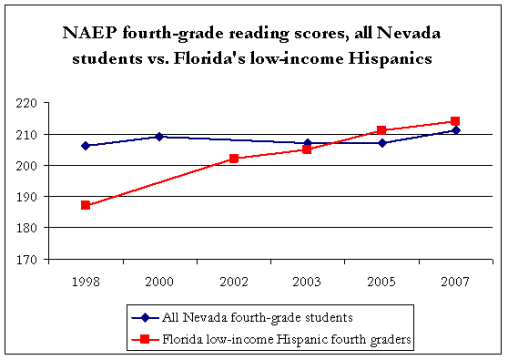How much for a gallon of education?
When gas prices climbed over $4 a gallon earlier this summer, many Americans were outraged. Whether it is through government action or private solutions, citizens are demanding relief. But the rise in fuel prices over the last four decades pales in comparison to increases in per-pupil spending on public education in America. From 1961-2007, per-pupil spending increased by 293 percent after adjusting for inflation.
If gasoline prices had risen that swiftly, we would be paying about $7.34 a gallon today. Where is the outrage? Where is the desire for cost-effective alternatives?
In 1961 the average state spent about $2,725 per pupil (in 2007 dollars). When capital expenditures and school debt are included, Nevada spent over $9,179 per student in 2005 (also in 2007 dollars), according to the National Center for Education Statistics. Children in 1961 weren't doomed or threatened by this "meager" education funding, nor are Nevada's children educated any better today.
Despite the rapid growth in spending devoted to education, numerous supporters of Big Education in Nevada's Legislature, including Assembly Speaker Barbara Buckley (D-Las Vegas), are claiming that budget cuts are threatening education and that tax hikes are needed. Nothing could be further from the truth.
Public education is spending more money per-pupil than at any point in history, and we have very little to show for it. Reading scores for Nevada eighth-grade students on the National Assessment for Educational Progress (NAEP) test continue to show declines, and recent math score improvements have only been marginal. According to the National Center on Education Statistics, ACT and SAT scores for Nevada's students have remained flat over the last decade.
Some may attempt to attribute Nevada's educational shortcomings to the influx of Hispanics, but this thinking is wrongheaded. Dr. Matthew Ladner, vice president of research at the Goldwater Institute in Phoenix and a policy fellow of the Nevada Policy Research Institute, has found that low-income Hispanics in Florida outperform the average student in several states, including not only Nevada but also the liberal state of Oregon, which is 91 percent white.

Dr. Ladner discovered that the high achievement growth for Hispanics and African-Americans, especially low-income students, in Florida was the result of several genuinely progressive education reforms in that state – including tuition scholarship programs, expanded charter school options, improvements to alternative teacher certification methods, and the introduction of a form of merit pay for teachers.
So while Florida is moving forward with an educational plan that increases performance for all students, especially the neediest, Nevada has taken massive steps backward by slamming the door shut on reforms that work.
Demanding more money for education is political pandering, not a solution to Nevada's educational needs. Hopefully the Legislature will start looking at what works for the students, and not what works for their re-election hopes.
Patrick R. Gibbons is a researcher for the Nevada Policy Research Institute. This commentary also appeared in the Reno Gazette-Journal
*Note, excluding capital expenditures and school debt, inflation adjusted per-pupil spending increased 247 percent from 1961-2006. It is unclear, however, whether or not the 1961 figure for per-pupil spending includes or excludes capital expenditures and school debt. 247 percent should be considered a low-end estimate. At that rate of increase, gas prices would have been approximately $6.18 in 2006.